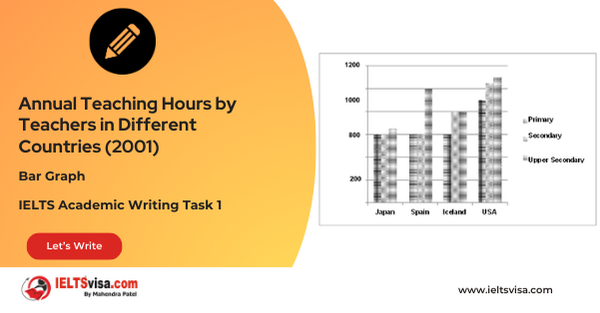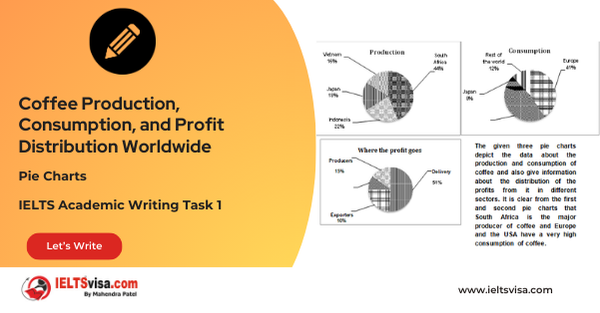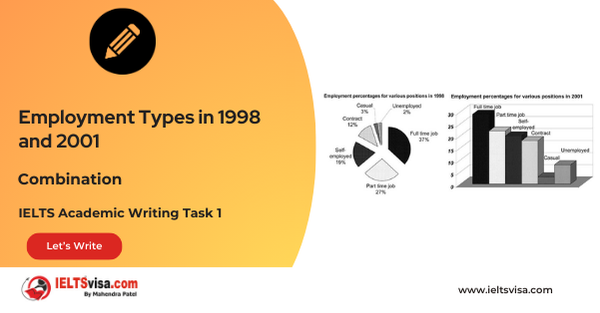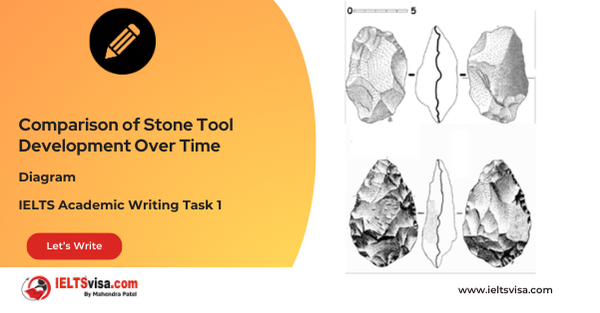Information about students studying in six departments in an Australian university in 2011
IELTS Academic Writing Task 1 - Tables
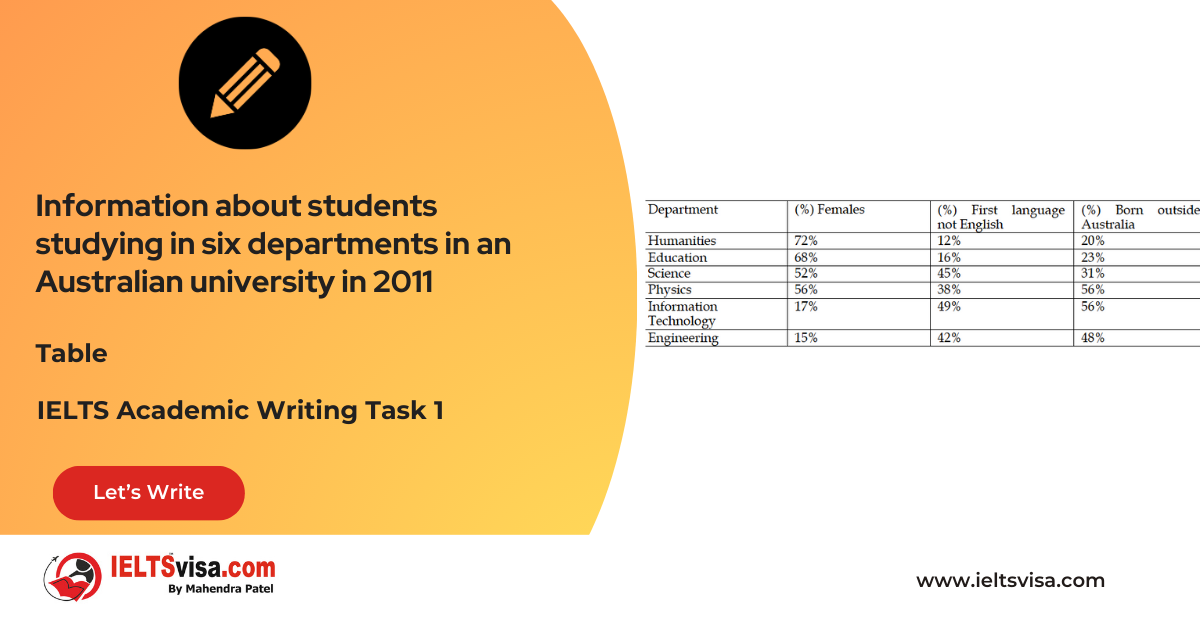
IELTS Writing Task 1 Question
The table below gives information about students studying in six departments in an Australian university in 2011. Summarise the information making comparisons where relevant.

Common Questions for the Table
1. Graph Type: Table
2. Title: Student Distribution in Six Departments at an Australian University in 2011
3. What are the units of measurement?: Percentage of students
4. Who: Students studying in six different departments
5. When: 2011
6. Where: An Australian university
7. Topic: Gender distribution and language background of students in various academic departments
Comparison Showing and Trends Any change over time (such as an increase or a decrease) is a trend.
Comparison 1 : Gender Distribution
- Details:
1. More females than males studied in the Arts and humanities departments.
2. In the humanities department, females made up 72% of the student population, while in information technology and engineering, they constituted only 17% and 15% respectively.
Comparison 2 : Non-Native Speakers
- Details:
1. The proportion of non-native English speakers was below 50% across all departments.
2. Science subjects attracted a relatively higher percentage of non-native speakers, ranging from 38% to 49%, while humanities and education had lower percentages at 12% and 16% respectively.
Comparison 3 : Foreign Student Proportion
- Details:
1. Physics and information technology departments had the highest percentages of foreign students at 56% each.
2. Engineering followed with 48%, while science had 31%. Humanities and education had the lowest foreign student representation, comprising only 20% and 23%, respectively.
Sample Answer
The table provided illustrates the distribution of students across six departments in an Australian university in 2011, highlighting differences in gender and language background.
Overall, it is evident that while more females than males enrolled in Arts, non-native speakers showed a preference for Science subjects.
In the humanities, education, science, and physics departments, over half of the students were female, with the humanities department having the highest female representation at 72%. Conversely, only 17% and 15% of students in information technology and engineering were female, respectively.
Regarding language background, non-native English speakers constituted less than half of the department’s student population. Science subjects had a relatively higher percentage of non-native speakers, ranging from 38% to 49%, whereas humanities and education had only 12% and 16%, respectively.
The trend for foreign students mirrored that of non-native speakers, with physics and information technology leading at 56% each, followed by engineering at 48%. Humanities and education departments had the lowest foreign student representation, at just 20% and 23%.
Top 28 Vocabularies
| Vocabulary | Type | Meaning | Synonyms | Examples |
| Proportion | Noun | A part or share of the whole | Ratio, fraction | “More females than males studied in Arts.” |
| Preference | Noun | A greater liking for one alternative over another | Choice, inclination | “Non-native speakers preferred Science subjects.” |
| Representation | Noun | The action of speaking or acting on behalf of someone | Depiction, portrayal | “Females made up 72% of the student population in humanities.” |
| Enrollment | Noun | The act of enrolling or being enrolled | Registration, admission | “The distribution of students across six departments.” |
| Gender distribution | Noun | The relative numbers of males and females in a population | Gender ratio | “Gender distribution varied significantly by department.” |
| Illustrates | Verb | To show or explain in detail | Demonstrates, depicts | “The table illustrates the distribution of students across departments.” |
| Distribution | Noun | The way something is spread or allocated | Allocation, dispersion | “The distribution of students varied across departments.” |
| Department | Noun | A specific division of study or faculty | Division, section | “There were six departments represented in the table.” |
| Background | Noun | The circumstances or facts that form the setting | Context, history | “The students’ language background differed across departments.” |
| Enrolled | Verb | To sign up or register for a course or program | Registered, signed up | “More females than males were enrolled in the Arts department.” |
| Preference | Noun | A greater liking for something | Inclination, choice | “Non-native speakers showed a preference for Science subjects.” |
| Represented | Verb | To be present or included in a group | Depicted, portrayed | “Females represented 72% of students in the humanities department.” |
| Proportion | Noun | A part or share in relation to the whole | Ratio, fraction | “The proportion of females in the engineering department was very low.” |
| Non-native speakers | Noun | Individuals who speak a language that is not their first | Foreign speakers, second-language speakers | “Non-native speakers made up a significant portion of Science students.” |
| Constituted | Verb | To make up or form part of a whole | Composed, formed | “Non-native speakers constituted less than half of the department’s population.” |
| Language background | Noun | The linguistic origin or proficiency of a person | Linguistic background | “Students’ language background influenced their department preference.” |
| Significantly | Adverb | In a way that is important or noticeable | Considerably, notably | “The number of females in humanities was significantly higher than in IT.” |
| Diverse | Adjective | Showing a great deal of variety | Varied, different | “The department had a diverse group of students with varying language backgrounds.” |
| Rate | Noun | The amount or degree of something measured over time | Percentage, proportion | “The rate of female students was highest in the humanities.” |
| Trend | Noun | A general direction or pattern | Pattern, movement | “The trend for foreign students mirrored that of non-native speakers.” |
| Foreign students | Noun | Students who come from countries other than the one where they study | International students, overseas students | “Physics had the highest percentage of foreign students.” |
| Contrast | Verb/Noun | To compare in order to highlight differences | Differentiate, compare | “The proportion of female students in engineering contrasted sharply with that in humanities.” |
| Relatively | Adverb | In comparison with something else | Comparatively, somewhat | “Science had a relatively higher proportion of non-native speakers.” |
| Percentage | Noun | A rate or proportion per 100 | Ratio, share | “The percentage of foreign students in IT was high.” |
| Representation | Noun | The act of portraying or acting on behalf of someone | Depiction, portrayal | “The representation of females in the humanities was the highest.” |
| Demonstrated | Verb | To show or prove clearly | Showed, exhibited | “The data demonstrated that female students were more likely to enroll in humanities.” |
| Incorporated | Verb | To include or combine as part of something | Included, combined | “Non-native speakers were incorporated into the Science departments in significant numbers.” |
| Proportionate | Adjective | Being in correct or balanced proportion | Balanced, equal | “The proportionate distribution of students across departments varied.” |

Our Books
Master IELTS Speaking Part 1
IELTS Writing Task 1 Book
IELTS Writing Task 2 Book
Writing Task 1 Question Types
Practice IELTS Other Modules
IELTS Listening
The IELTS Listening test assesses how well you can understand spoken English in various contexts. It lasts about 30 minutes and is divided into four sections with a total of 40 questions. The listening tasks become increasingly difficult as the test progresses.
IELTS Academic Reading
The IELTS Academic Reading section assesses your ability to understand and interpret a variety of texts in academic settings. It is designed to evaluate a range of reading skills, including skimming for gist, reading for main ideas, reading for detail, understanding inferences, and recognizing a writer's opinions and arguments.
IELTS Speaking
The IELTS Speaking test assesses your ability to communicate in English on everyday topics. It lasts 11-14 minutes and consists of three parts: introduction, cue card, and a discussion based on the cue card topic.
IELTS General Reading
IELTS General Reading tests your ability to understand and interpret various types of texts. Here are some key areas and types of content you can expect to encounter in the reading section, along with tips for effective preparation.
IELTS Academic Writing Task 1
In IELTS Academic Writing Task 1, you are presented with a visual representation of information, such as graphs, charts, tables, or diagrams, and you are required to summarize, compare, or explain the data in your own words.
IELTS General Writing Task 1
In IELTS General Writing Task 1, you are required to write a letter based on a given situation. The letter can be formal, semi-formal, or informal, depending on the prompt. Here’s a breakdown of the key components to include in your letter
IELTS Academic Writing Task 2
In IELTS Academic Writing Task 2, you are required to write an essay in response to a question or topic. Here’s a guide to help you understand the essential elements of this task
IELTS Exam Tips
To succeed in the IELTS exam, practice regularly, familiarize yourself with the test format, improve your vocabulary, develop time management skills, and take mock tests to build confidence.
Grammer for IELTS
Grammar is the foundation of effective communication in English. Understanding tense usage, subject-verb agreement, and sentence structure enhances clarity and coherence in writing and speaking.
Vocabulary for IELTS
Vocabulary plays a crucial role in the IELTS (International English Language Testing System) exam, especially in the Speaking and Writing sections. Here’s an overview of why vocabulary is important and how it impacts your performance
RECENT IELTS SAMPLES QUESTIONS AND ANSWERS
Task 1 – Column graph – Percentage of Young People Enrolled in Universities in 2000 and 2007.
20:00 Start Pause Stop [df_adh_heading title_infix="IELTS Writing Task 1 Question" use_divider="on"...
Task 1 – Bar Graph – Annual Teaching Hours by Teachers in Different Countries (2001)
20:00 Start Pause Stop [df_adh_heading title_infix="IELTS Writing Task 1 Question" use_divider="on"...
Task 1 – Pie Charts – Coffee Production, Consumption, and Profit Distribution Worldwide
20:00 Start Pause Stop [df_adh_heading title_infix="IELTS Writing Task 1 Question" use_divider="on"...
Task 1 – Column graph – Types of Transport Used by Tourists Visiting New Zealand from Five Countries in 2004.
20:00 Start Pause Stop [df_adh_heading title_infix="IELTS Writing Task 1 Question" use_divider="on"...
Task 1 – Bar and Pie Chart Combination – Employment Types in 1998 and 2001
20:00 Start Pause Stop [df_adh_heading title_infix="IELTS Writing Task 1 Question" use_divider="on"...
Task 1 – Diagram – Comparison of Stone Tool Development Over Time
20:00 Start Pause Stop [df_adh_heading title_infix="IELTS Writing Task 1 Question" use_divider="on"...


